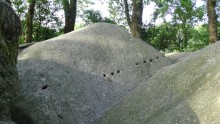|
|
|
|
SievernPassage Grave
|
||||||||||||||||||
|
|
|
Images (click to view fullsize) |
|
Photographs:









 Maps / Plans / Diagrams:
Maps / Plans / Diagrams:

|
Fieldnotes |
|
|
The Bülzenbett is a passage grave with an approximately 8 × 4.7 meter chamber, with internal dimensions of about 2.0 to 2.5 × 6 meters with the three colossal capstones, one of which measures 4 × 3 meters. The middle capstone was blown up between 1604 and 1755, it still has a number of drill holes and is partially fallen into the interior of the chamber. The capstones are resting on nine support stones. A support stone on the southern long side is missing. The Bülzenbett has a trapezoidal enclosure of about 35 m in length. Of their original 55 stones are still 33 available. Many are still in their original position, some were set up again during the restoration in 1970. They form an easterly rejuvenating trapeze measuring 8.5 by 6.5 by 35.5 meters. In the middle of the 19th century, a small stone chamber was found within the enclosure, in which a hatchet and a flint dagger were found. The capstones of the burial chamber of Bülzenbett should be among the largest capstones of all megalithic tombs in Germany. Even the two parts of the blasted middle capstone are still huge! A visit along with the nearby Pipinsburg and a hike on the archaeological trail is not only interesting because of the monuments lying along the way, but also very scenic! To get to the tomb, take the L135 from Sievern northwards towards Holßel. After 750 m you come to a car park for the Pipinsburg on the right side. Visited June 2019 |
6th December 2019ce Edited 6th December 2019ce |
|
taken from the on-site information board: Megatilthic tomb "Bülzenbett" The Bülzenbett is a megalithic tomb of the Neolithic Funnel Beaker Culture (2nd half 3rd millennium BC). The burial chamber consists of nine support stones (formerly 10) and three capstones. The middle capstone was blown up and thereby partially fell into the interior of the burial chamber. The still recognizable drill holes indicate that it should be further crushed and then driven off. The date of the damage can be determined relatively accurately: on a copperplate engraving made by Wilhelm Dilich from 1604 the Bülzenbett is shown intact, in 1755 Martin Mushard illustrated the Bülzenbett with the damaged capstone, as can still be seen today. When the archaeological preservation of the district in the summer of 1970 put the entire complex back in a state worth visiting, the enclosing stones of the trapezoidal enclosure (Hünenbett) were raised again. |
6th December 2019ce Edited 6th December 2019ce |

